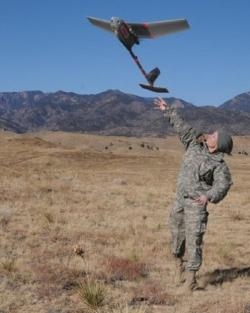Assisted In A Pre-Deployment Exercise At Various Locations In The State
Colorado Wing recently wrapped up a new Civil Air Patrol mission involving support for the U.S. Army’s unmanned aerial vehicle program, part of the U.S. Air Force auxiliary’s evolving profile of homeland security missions for America. Wing aircrews assisted the 2nd Brigade Combat Team, 4th Infantry Division, in a pre-deployment exercise for soldiers from Fort Carson at the Pinon Canyon Maneuver Site near Trinidad. The training covered a three-week period that began in late February.

“The capability of CAP aircrews gave members of the UAV team their first-ever opportunity to fly their UAV in support of the brigade exercise that are part of operational training and evaluation prior to deployment,” said CAP’s incident commander for the mission, Maj. William O’Connor. Planning for the mission began in late 2012 when Civil Air Patrol and the Colorado Wing were approached with the concept of escorting the Army UAV. “The FAA requires UAVs operating outside of restricted airspace to be within line of sight of observers on the ground and/or in an aircraft,” said O’Connor. “Due to the size of the training area, the Army needed aerial observation. CAP was a cost-effective option for the Army.”
In addition to O’Connor, members of the initial CAP planning team included Lt. Col. Mike McDonald as backup incident commander and the Colorado Department of Military and Veterans Affairs contact, and Gerald Peaslee, CAP-U.S. Air Force Liaison Region-assistant director of operations for Colorado, as the Air Force representative on the team.
Participants developed an operational plan that involved a three-step process to ensure the safety and precision of the link-up between the CAP aircraft and UAV. Training involved both the UAV operational team on the ground and the CAP aircrews. Subsequent planning meetings refined the procedures to provide a repeatable process that was safe.
The Colorado Wing planning team and pilots’ training lasted an entire week. Using Perry Stokes Airport in Trinidad as the base, pilots flew training sorties that began with flying the link-up route and perfecting the communications process with the Army UAV ground control team at the Pinon Canyon Army site.
CAP pilots involved in the training were O’Connor, Lt. Cols. Dave Novotny, Jim Jenkins and Jer/ Eberhard, Capts. John Cossick and Darrell Vick and 1st Lt. Rob Pehkonen. "The link-up process depended on the precise coordination of the aircrew and UAV ground controller, as there is an eight-second window to acquire visual contact with the UAV and take up the escort of the UAV 500 feet back and well clear of the UAV,” said O’Connor.

The mission for the UAV was to support the field commander’s requirements for “eyes in the sky” in support of simulated combat against an aggressor. The mission of the CAP aircraft was to provide escort for the UAV as it flew in public airspace in the Pinon Canyon Military Operations Area. “Without our support, the brigade from Fort Carson would have had to travel to the National Training Center at Fort Irwin, CA, at a cost of millions. CAP offered a cost-saving, local solution to support the training and qualification needs of the Army in this era of reduced military budgets.”
The results of the four-hour sortie were, in the words of the brigade commander, “outstanding” and “brilliant,” and provided further proof that CAP’s mission profile is changing as the needs of its potential customers change. “CAP’s unique capability to provide trained and professional aircrew support for a variety of missions means greater opportunities to serve the needs of our customers in a safe and professional manner consistent with our history,” said O’Connor.
CAP has been participating in homeland security missions for America since World War II, when private pilots who helped form the organization provided coastal patrols to protect U.S. ships from enemy submarines. Since 9/11, when CAP documented damage from the terrorist attacks in New York City, CAP has stepped up its homeland security missions, providing aerial imaging to government emergency management agencies, escorting naval vessels and supporting combat deployment preparation training for the Air Force.
CAP pilots also simulate hostile aircraft for Air Force and Air National Guard fighters during practice intercept missions nationwide. Over the last five years, aircrews’ intercept mission totals have risen by more than 50 percent.
(Army UAV training image from file)
 ANN's Daily Aero-Linx (04.15.24)
ANN's Daily Aero-Linx (04.15.24) Classic Aero-TV: 'No Other Options' -- The Israeli Air Force's Danny Shapira
Classic Aero-TV: 'No Other Options' -- The Israeli Air Force's Danny Shapira Aero-News: Quote of the Day (04.15.24)
Aero-News: Quote of the Day (04.15.24) Airborne 04.16.24: RV Update, Affordable Flying Expo, Diamond Lil
Airborne 04.16.24: RV Update, Affordable Flying Expo, Diamond Lil ANN's Daily Aero-Term (04.16.24): Chart Supplement US
ANN's Daily Aero-Term (04.16.24): Chart Supplement US




